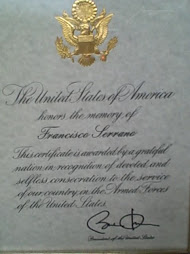


Francisco Serrano was added to the gallery of the many Legions of Veterans that have been honored by their Country and the Armed Forces for their Service to the Nation that they protected. Here are some highlights of the ceremonies at Bay Pines National Cemetery in Pinellas Park, FL. We have also enclosed a brief history of past Military Honors and its origin as a fitting tribute to Francisco Serrano. In the summer of 1862, George F. Root was putting the finishing touches on the words and music of the "Battle Cry of Freedom" that would be adopted as a national anthem (in different versions) by both the Union and the Confederacy. It was the second summer of a terrible war that few had believed would last more than several months. Thousands had already died at places like Wilson's Creek, Bull Run, Shiloh, and Fort Donelson.
On July 17 of that year, Congress enacted legislation that authorized the President to purchase "cemetery grounds" to be used as national cemeteries "for soldiers who shall have died in the service of the country." Fourteen cemeteries were established that first year, including one in the sleepy Maryland town of Sharpsburg where 4,476 Union soldiers were laid to rest after the one day of terrible slaughter that was the Battle of Antietam. (By way of comparison, approximately 3,000 Americans, British and Canadians died on June 6, 1944, in the invasion of Normandy).
By 1870, the remains of nearly 300,000 Union dead had been buried in 73 national cemeteries. Most of the cemeteries were located in the southeast, near the battlefields and campgrounds of the Civil War. After the war, Army crews scoured the countryside to locate the remains of soldiers who had died in battle. They were buried with honor in the new national cemeteries, which were enclosed by brick walls and entered by means of ornate gates. Tragically, however, the identities of nearly half of those who died in service to the Union and are buried in national cemeteries are unknown.
The National Cemetery Administration has evolved slowly since the initial period of great challenge associated with the Civil War. All honorably discharged veterans became eligible for burial in 1873. Cemeteries associated with military posts on the western frontier, such as Fort McPherson, Nebraska, were added to the system in the late 19th century.
In the 1930s, new national cemeteries were established to serve veterans living in major metropolitan areas such as New York, Baltimore, Minneapolis, San Diego, San Francisco, and San Antonio. Several, closely associated with battlefields such as Gettysburg, were transferred to the National Park Service because of their value in interpreting the historical significance of the battles. In 1973, Public Law 93-43 authorized the transfer of 82 national cemeteries from the Department of the Army to the Veterans Administration, now the Department of Veterans Affairs (VA). Joining with 21 VA veterans cemeteries located at hospitals and nursing homes, the National Cemetery System comprised 103 cemeteries after the transfer.
On November 11, 1998, the President signed the Veterans Programs Enhancement Act of 1998 changing the name of the National Cemetery System (NCS) to the National Cemetery Administration (NCA).
Today, there are 141 national cemeteries in all. VA, through its National Cemetery Administration, administers 125 of them. Two national Cemeteries—Arlington and Soldiers Home—are still administered by the Army. Fourteen national cemeteries are maintained by the Department of the Interior.
More than 3 million Americans, including veterans of every war and conflict—from the Revolutionary War to the Gulf War—are honored by burial in VA's national cemeteries. Approximately 17,000 acres of land from Hawaii to Maine, and from Alaska to Puerto Rico are devoted to the memorialization of those who served this nation. More than 300 recipients of the Medal of Honor are buried in VA's national cemeteries.
In April 2007, VA opened its 125Th cemetery—South Florida VA National Cemetery. Currently 65 VA cemeteries (in 34 states) are able to provide the full range of service to America's veterans and their families. An additional 21 provide burial for family members already buried and they can also bury cremated remains.
In 1999 and 2003, with the passage of two laws, Congress directed VA to establish 12 new national cemeteries. One has been opened in Oklahoma, one in Pennsylvania, one in Michigan, one in Georgia, one in California, and one in Florida. The rest – one in Alabama, one in California, two in Florida, one in Pennsylvania and one in South Carolina – will be located near large populations of veterans who currently do not have access to a burial option.
In addition to providing a grave site and a grave liner, VA opens and closes the grave, provides a headstone or marker, a Presidential Memorial Certificate, a U.S. Flag, and perpetually cares for the grave at no cost to the veteran's family.
Today, more than 24 million veterans and Reservists and National Guard members with 20 years qualifying service (who are entitled to retired pay or would be entitled, if at least 60 years of age), have earned the honor of burial in a national cemetery. Veterans with discharges other than dishonorable, their spouses and dependent children may be eligible for burial in a VA national cemetery. Those who die on active duty may also be buried in a national cemetery. Francisco Serrano is now buried at Bay Pines National Cemetery along with his beloved wife Felicita M. Serrano and their youngest son Wilson Serrano. There will be no more family members buried at this site. This will be a very special place for the Serrano family. We all know that they now rest in the Arms of the Almighty, but this burial site has always been a place to reflect and honor their memory. Now, even more so with the final resting place of Francisco Serrano. We will never forget them and we will always Honor them.



No comments:
Post a Comment